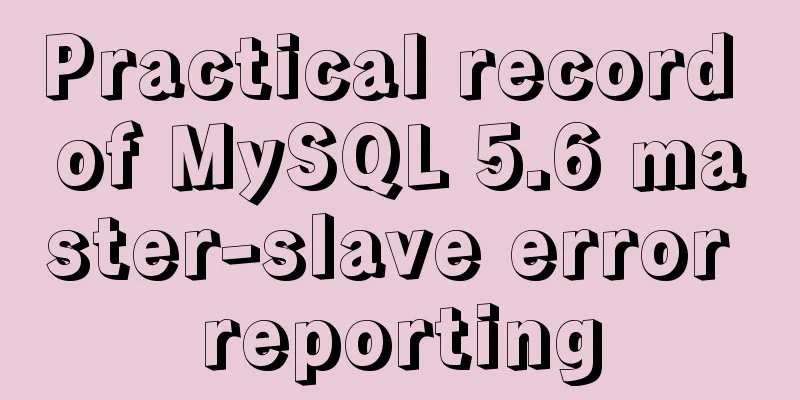MySQL 5.6 binary installation process under Linux

|
1.1 Download the binary installation package wget https://dev.mysql.com/get/Downloads/MySQL-5.6/mysql-5.6.40-linux-glibc2.12-x86_64.tar.gz 1.2 Create mysql user and group groupadd -r -g 306 mysql useradd -r -g 306 -u 306 -m -s /sbin/nologin mysql 1.3 Decompression tar xf mysql-5.6.40-linux-glibc2.12-x86_64.tar.gz -C /usr/local 1.4 Create a mysql soft connection cd /usr/local ln -s mysql-5.6.40-linux-glibc2.12-x86_64 mysql 1.5 Modify the owner and group permissions chown -R mysql.mysql /usr/local/mysql-5.6.40-linux-glibc2.12-x86_64 chown mysql.mysql /usr/local/mysql 1.6 Create a directory and modify the owner of the mysql directory
mkdir -p /data/mysql{,_binlog}
chown -R mysql.mysql /data/mysql
chown -R mysql.mysql /data/mysql_binlog1.7 Create a configuration file directory mkdir /etc/mysql/ cp /usr/local/mysql/support-files/my-default.cnf /etc/mysql/my.cnf 1.8 Configuration file vim /etc/mysql/my.cnf [client] port = 3306 socket = /data/mysql/mysql.sock [mysqld] port = 3306 user = mysql basedir = /usr/local/mysql datadir = /data/mysql socket = /data/mysql/mysql.sock pid-file = /data/mysql/mysql.pid log-error = /data/mysql/mysql_error.log character-set-server = utf8 init_connect='SET NAMES utf8' innodb_log_file_size = 256M innodb_file_format = barracuda innodb_strict_mode = 0 innodb_file_per_table = on #Skip host name resolution skip-name-resolve #Server ID, a required configuration for the cluster, distinguish the machine number, each machine has a different server_id = 1 #Open binary log, row-level logging, synchronous writing to disk log_bin = /data/mysql_binlog/mysql-bin binlog_format = row sync_binlog = 1 sql_mode = 'STRICT_TRANS_TABLES,NO_ZERO_IN_DATE,NO_ZERO_DATE,ERROR_FOR_DIVISION_BY_ZERO,NO_AUTO_CREATE_USER,NO_ENGINE_SUBSTITUTION' symbolic-links=0 1.9 Modify the PATH environment variable
]# vim /etc/profile.d/mysql.sh
PATH=/usr/local/mysql/bin:$PATH
]# source /etc/profile.d/mysql.sh2.0 Create database files cd /usr/local/mysql/ ./scripts/mysql_install_db --datadir=/data/mysql --user=mysql 2.1 Prepare the startup script cd /usr/local/mysql/ ./scripts/mysql_install_db --datadir=/data/mysql --user=mysql 2.2 Secure Initialization ln -s /data/mysql/mysql.sock /tmp/mysql.sock mysql_secure_installation root has no password --> Press Enter --> Set a password Y Enter the password --> Delete anonymous users Y --> Disable root remote connection N --> Delete the test database Y --> Reload the database Y ---> OK 2.3 Master-slave replication architecture 2.3.1 Configuration File master master database log_bin=/bin_log_PATH/mysql-bin turns on binary log binlog_format = row binary log recording mode, row-level recording server_id = 1 2.3.2 Create a user with special permissions for master-slave replication mysql> grant replication salve on *.* to 'repluer'@'172.16.1.%' identified by '123456' 2.3.3 Refresh binary log mysql> reset master; mysql> show master status;
2.3.3 slave database configuration file server_id=2 2.4 Establishing a master-slave relationship mysql> change master to master_host='172.16.1.211', master_user='repluser',master_password='123456', master_log_file='mysql-bin.000001',master_log_pos=120; 2.4.1 View and enable slave nodes mysql> start slave; mysql> show slave status\G Note: The master-slave replication architecture is to synchronize the data of a master with multiple slaves, which may cause great pressure on the master node. You can use master-slave cascade replication, where the master node is responsible for one slave node, and the slave node is responsible for the next slave node. Mainly used configuration Slave node configuration log_bin binary logging configuration log_slave_updates writes the synchronized data into the binary log to facilitate synchronization with the next slave node Summarize The above is the MySQL 5.6 binary installation process under Linux introduced by the editor. I hope it will be helpful to everyone. If you have any questions, please leave me a message and the editor will reply to you in time. I would also like to thank everyone for their support of the 123WORDPRESS.COM website! You may also be interested in:
|
<<: Linux yum package management method
>>: How to install Linux online software gcc online
Recommend
Vue+element implements drop-down menu with local search function example
need: The backend returns an array object, which ...
HTML+CSS to achieve simple navigation bar function
Without further ado, I'll go straight to the ...
How to set the default value of a MySQL field
Table of contents Preface: 1. Default value relat...
Detailed explanation of three ways to cut catalina.out logs in tomcat
1. Log4j for log segmentation 1) Prepare three pa...
Install and deploy java8 and mysql under centos7
Generally, learning Java and deploying projects a...
A brief discussion on Yahoo's 35 rules for front-end optimization
Abstract: Whether at work or in an interview, opt...
Method example of safely getting deep objects of Object in Js
Table of contents Preface text parameter example ...
Summary of related functions for Mysql query JSON results
The JSON format field is a new attribute added in...
MySQL Tutorial: Subquery Example Detailed Explanation
Table of contents 1. What is a subquery? 2. Where...
How to implement Ajax concurrent request control based on JS
Table of contents Preface Ajax serial and paralle...
Example of troubleshooting method to solve Nginx port conflict
Problem Description A Spring + Angular project wi...
Ubuntu Server 16.04 MySQL 8.0 installation and configuration graphic tutorial
Ubuntu Server 16.04 MySQL 8.0 installation and co...
Example of using Nginx reverse proxy to go-fastdfs
background go-fastdfs is a distributed file syste...
MySQL case when group by example
A mysql-like php switch case statement. select xx...
Nofollow makes the links in comments and messages really work
Comments and messages were originally a great way...










